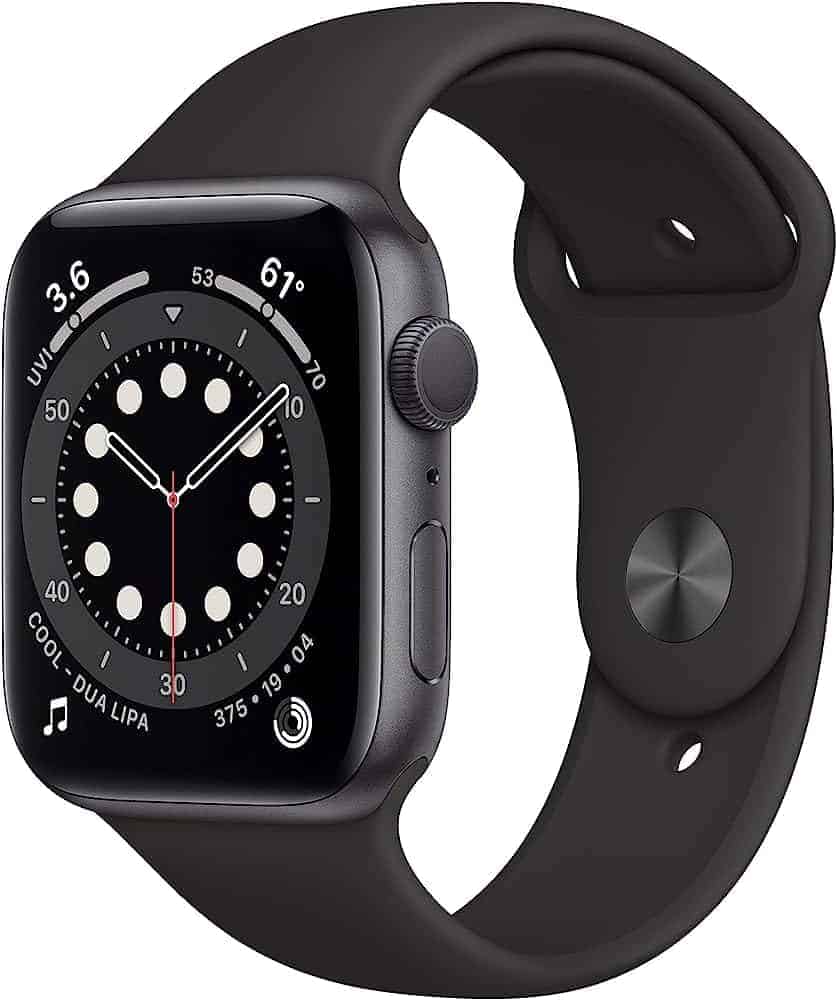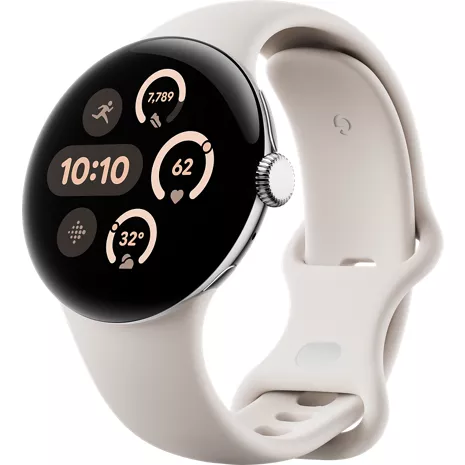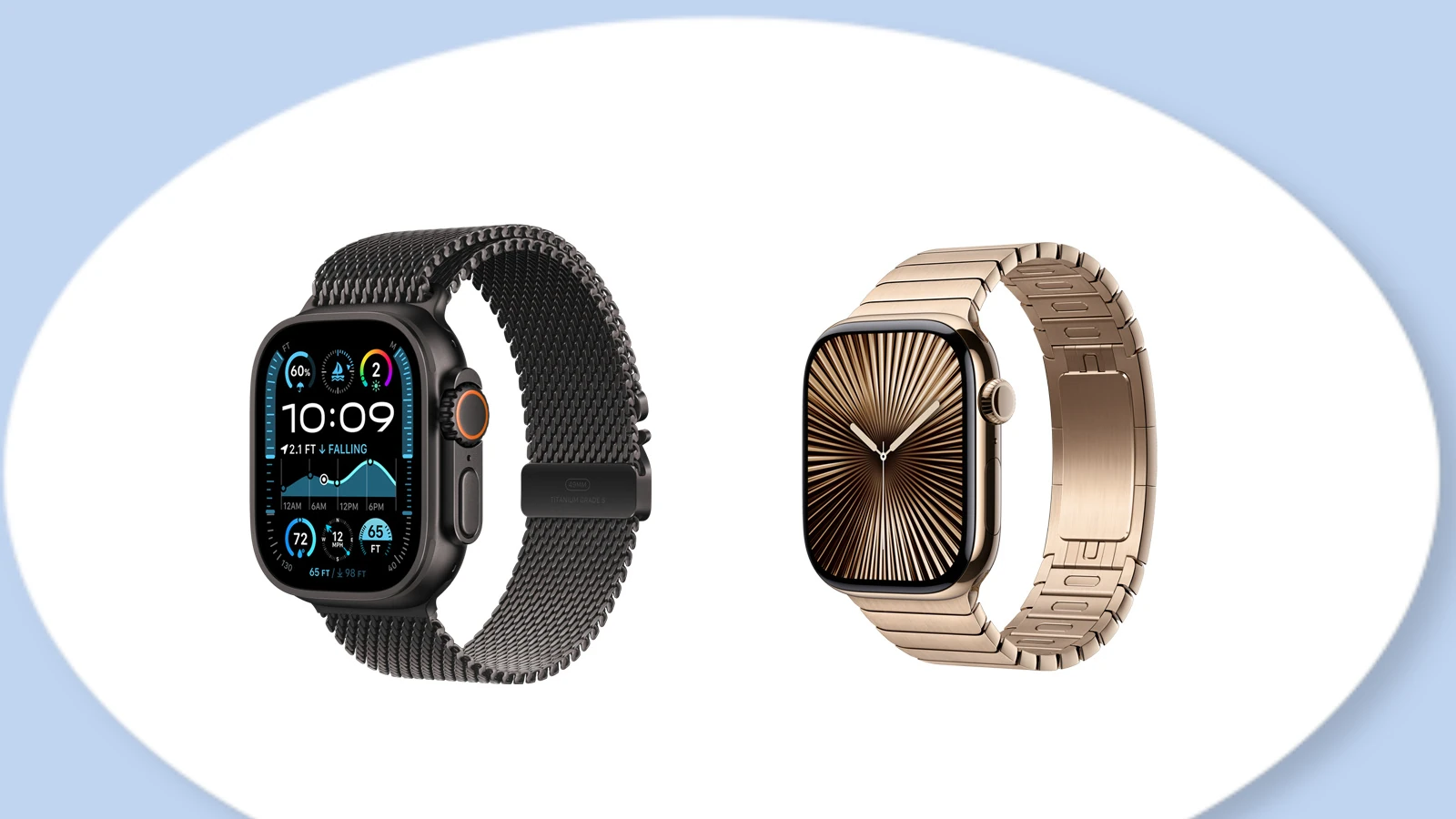The smartwatch scene in 2025 looks less like an accessories aisle and more like a Formula 1 grid—each brand fine-tuning hardware, layering AI into the software stack, and pushing health tech toward genuine medical usefulness.
This year’s standout models don’t just buzz your wrist when you get a text; they coach your marathon pacing, warn you if your vascular load is creeping too high, and can even call emergency services the moment a pulse flat-lines.
Below is a snapshot of the year’s most compelling releases and why each earns a place on your shortlist.
Apple Watch Series 10 — Best Overall for iPhone Users

Apple thinned the chassis, stretched the bezels to almost nothing, and dropped in the S10 SiP, a 3-nm chip that’s faster and, crucially, more power-efficient. Two-finger “pinch-and-flick” gestures let you navigate without touching the screen—handy when you’re carrying groceries or on the treadmill. The bigger OLED panel tops 2,000 nits, making it readable in Nevada’s noon sun, while water-depth tracking finally brings dive-computer basics to the mainstream model. Expect about 36 hours on a charge with the always-on display enabled.
Apple Watch Ultra 2 — Best for Adventures & Endurance
The Ultra 2 retains the 49 mm titanium shell but squeezes in a denser battery (up to three days normal use), dual-band GPS that rivals dedicated Garmins for accuracy, and a new Night-Sight display mode that shifts the palette to red hues to preserve night vision. The Action Button’s custom shortcuts now extend to third-party apps, so you can launch Strava Beacon or backtrack in AllTrails with a single press.
Samsung Galaxy Watch 8 / Watch 8 Classic — Best All-Rounder for Android
Launching July 9, the Galaxy Watch 8 line ushers in Samsung’s 3-nm Exynos W1000 and “Galaxy AI” suite. Vascular Load Tracking estimates cardiovascular strain in real time, while an on-watch Gemini assistant translates messages on the fly or drafts replies from quick prompts. The Classic revives the rotating bezel—this time around a squircle housing—and pairs it with a bright 1.5-inch AMOLED display. Even better: Samsung finally cracked a solid two-day battery with LTE enabled.
Google Pixel Watch 3 — Best Size-to-Feature Ratio

Google’s third-gen circular watch stays compact but adds an optical sensor capable of detecting a complete loss of pulse and triggering an auto-dial to emergency services. Fitbit Running Insights layer on AI-generated pacing strategies mid-run, and the Snapdragon W5 chip nudges battery life past 30 hours with always-on display. Google Assistant can now handle multi-step smart-home routines triggered from your wrist.
OnePlus Watch 3 — Best Value for Android
At roughly half the price of flagship competitors, the Watch 3 packs a 1.5-inch AMOLED capable of 2,000 nits, a titanium bezel and crown, and a five-day battery that fast-charges from 0–65 % in ten minutes. It tracks more than 100 workout modes, stitches GPS routes directly on-device, and bakes in recovery-time predictions borrowed from the brand’s health phones. The trade-off: there’s still no iOS support.
Garmin Forerunner 570 — Best for Dedicated Athletes
Garmin’s lightweight nylon build (42 mm and 47 mm sizes) hides dual-frequency GPS, wrist-based running-power metrics, and HRV-status trending. Battery life stretches to 10–11 days in smartwatch mode, while full GNSS + music playback still nets you an 18-hour ultramarathon. New Adaptive Training Plans adjust each run’s intensity based on last night’s sleep score and morning HRV.
Withings ScanWatch Nova Brilliant — Best Hybrid Health Tracker
If you balk at glowing screens, Withings squeezes medical-grade ECG, SpO₂, and VO₂ max estimates behind an analog dial. A tiny PMOLED sub-display surfaces notifications only when you need them, so the watch coasts for a full month per charge. Sapphire crystal, 10 ATM water-resistance, and automatic sleep-apnea detection make it a stealth health device that looks like a Swiss diver.
Budget Picks Worth Noting
- Apple Watch SE (2nd gen) — Core Apple experience under $250, minus the fancy sensors.
- Samsung Galaxy Watch FE — Retains AMOLED, BioActive Sensor, and Wear OS perks for well under $200.
Quick-Match Guide
| Use Case / User Type | 2025 Top Pick |
|---|---|
| iPhone daily driver | Apple Watch Series 10 |
| Rugged, multi-day expeditions | Apple Watch Ultra 2 |
| Android all-rounder | Samsung Galaxy Watch 8 / 8 Classic |
| Android value | OnePlus Watch 3 |
| Serious training metrics | Garmin Forerunner 570 |
| Hybrid style + health focus | Withings ScanWatch Nova Brilliant |
Trends to Watch in the Back Half of 2025
- AI Coaching Everywhere – Expect Samsung’s Galaxy AI and Google’s Gemini to wind up in third-party Wear OS apps before the holidays.
- Blood-Pressure Cuffs May Become Obsolete – Both Samsung and Withings are field-testing cuff-less blood-pressure algorithms with FDA submissions underway.
- Battery Density Jumps – Multiple brands are trialing silicon-carbon anodes; 4-day Wear OS watches could be common by 2026.
- August-September Release Window – Rumors point to a Pixel Watch 4 with a Snapdragon W6 and an even lighter recycled-aluminum chassis.
Smartwatches are finally shifting from cute notification hubs to genuine health guardians and on-wrist AI assistants. Pick the watch that aligns with your ecosystem, fitness level, and style—then let it do the heavy lifting while you get on with life.
Key Takeaways
- Apple Watch Ultra 2 leads the market for iPhone users while Android users benefit from the Pixel Watch 3 and Galaxy Watch7 options.
- Smartwatch manufacturers have improved health tracking features, battery life, and overall design in their 2024-2025 models.
- Budget-friendly options like the Galaxy Watch FE and Apple Watch SE provide essential smartwatch features at more accessible price points.
Innovative Features and Advances in Smartwatch Technology
Smartwatches have evolved significantly in recent years, incorporating more powerful health monitoring capabilities, seamless operating system updates, and expanded connectivity options that transform how we interact with technology on our wrists.
Operating System Updates
The latest smartwatch operating systems have received substantial improvements in 2024-2025. Apple’s watchOS has become more intuitive with streamlined app navigation and improved battery optimization. Google’s Wear OS 5 offers enhanced customization options and faster performance on devices like the Pixel Watch 3.
These updates bring more responsive voice assistants that can complete complex tasks directly from the wrist. Users can now dictate longer messages, control smart home devices, and make queries with greater accuracy than previous generations.
Battery management has also improved significantly. New software optimizations help extend battery life by intelligently managing background processes and display usage, allowing many premium smartwatches to last multiple days on a single charge.
Health Monitoring Enhancements
Health tracking capabilities have taken a major leap forward in recent smartwatches. Advanced sensors now provide more accurate ECG (electrocardiogram) readings to detect irregular heart rhythms and potential signs of atrial fibrillation.
Sleep tracking has become more sophisticated with the ability to:
- Detect different sleep stages (light, deep, REM)
- Monitor breathing patterns
- Identify potential sleep apnea symptoms
Fall detection and crash detection features have expanded across more smartwatch models. These safety features can automatically contact emergency services if a serious fall or accident is detected and the user doesn’t respond.
Blood oxygen monitoring continues to improve in accuracy, with some models now offering continuous monitoring throughout the day rather than just on-demand readings. This provides better insights into overall respiratory health.
Expanded Connectivity and Integration
Modern smartwatches offer unprecedented connectivity options. Most premium models now include Bluetooth, Wi-Fi, and cellular capabilities, allowing them to function independently from smartphones for longer periods.
Contactless payments have become standard across most smartwatch platforms. Users can tap their watch at payment terminals, eliminating the need to carry physical cards or phones.
Integration with other devices has improved dramatically. Smartwatches now:
- Control smart home systems more effectively
- Unlock computers and vehicles
- Provide two-factor authentication
- Locate connected devices
Display technology has seen significant advancement with brighter OLED screens that use less power. These displays offer better outdoor visibility while maintaining excellent battery efficiency. Many new models feature more durable materials and increased water resistance ratings, making them suitable for swimming and watersports.
Leading Models and Market Innovations
The smartwatch market in 2024-2025 has evolved significantly with improved health tracking capabilities, longer battery life, and enhanced connectivity options. Major players continue to dominate while new competitors bring fresh approaches to wearable technology.
Top Picks for Fitness Enthusiasts
Fitness-focused users have excellent options in today’s smartwatch market. The Garmin Forerunner 265 stands out with its detailed training metrics and cardio load analysis, making it ideal for serious runners and triathletes. It offers up to 13 days of battery life in smartwatch mode.
The Garmin Venu 3 provides a more balanced approach with a bright AMOLED display and comprehensive fitness tracking while maintaining strong battery performance. Both models feature accurate GPS tracking and support for multiple workout types.
Apple Watch Ultra 2 targets outdoor enthusiasts with rugged design, precise dual-frequency GPS, and advanced metrics. Its Action Button enables quick access to workout functions.
For budget-conscious fitness fans, the Fitbit Ace LTE offers solid activity tracking fundamentals with reasonable battery life and simple interface at a lower price point.
Flagship Smartwatches from Major Brands
Apple continues its market leadership with the Apple Watch Series 10, featuring improved health sensors and a slimmer design. The more affordable Apple Watch SE provides essential functionality at a lower price point.
Samsung’s Galaxy Watch 7 introduces enhanced sleep tracking and a faster processor. Their new Galaxy Watch FE (Fan Edition) offers core features at a more accessible price. Both run on Wear OS with Samsung’s One UI overlay.
Key flagship smartwatch features in 2025:
| Brand | Top Model | Battery Life | Notable Features |
|---|---|---|---|
| Apple | Series 10 | Up to 36 hrs | Health sensors, slim design |
| Samsung | Galaxy Watch 7 | 2-3 days | BioActive sensor, advanced sleep tracking |
| Pixel Watch 3 | 24-48 hrs | Clean interface, Fitbit integration |
Most flagship models now offer music storage for offline playback with Bluetooth headphones and robust fitness tracking capabilities.
Smartwatch Alternatives and Emerging Players
Beyond traditional smartwatches, alternative wearables are gaining traction. The Withings ScanWatch combines analog watch design with health tracking in a hybrid approach with impressive 30-day battery life.
Smart rings are emerging as minimalist alternatives. They track basic health metrics without the bulk of a watch and typically offer 5-7 days of battery life.
Chinese manufacturers like Huawei, Oppo, and Vivo have expanded their smartwatch offerings with competitive pricing and features. The OnePlus Watch 2R delivers excellent battery performance at a mid-range price point.
Budget-friendly options under $150 now include respectable fitness tracking, basic notifications, and decent battery life. These affordable smartwatches often compromise on display quality and advanced sensors but serve casual users well.
Many alternative models prioritize compatibility across both Android and iOS, unlike some major brands that limit full functionality to their own ecosystems.
Frequently Asked Questions
Smartwatch technology has evolved significantly in 2024, with major advancements in health tracking, battery life, and cross-platform compatibility. These improvements have resulted in a wider selection of high-quality options across various price points.
What are the top 10 smartwatches of 2024 based on consumer ratings?
Based on consumer ratings and expert testing, the Apple Watch Ultra 2 currently holds the top position for overall best smartwatch. The Apple Watch Series 10 has also received high marks for its comprehensive feature set.
The Samsung Galaxy Watch7 ranks highly among Android users, offering excellent integration with Samsung phones and comprehensive health features. Google’s Pixel Watch 3 has gained popularity for its clean interface and improved battery life.
Other top-rated models include the Garmin Fenix series for serious athletes, Fitbit Sense 2 for health enthusiasts, and budget-friendly options from Amazfit and Xiaomi that now offer multi-satellite GPS without requiring daily charging.
Which smartwatches are considered the best for Android users in 2024?
The Samsung Galaxy Watch7 stands as the premier choice for Android users in 2024. Its seamless integration with the Android ecosystem and comprehensive health tracking capabilities make it particularly valuable for Samsung phone owners.
Google’s Pixel Watch 3 offers the purest Android experience with a clean interface and excellent Google service integration. The watch has addressed previous battery life concerns, now offering significantly improved performance.
For budget-conscious Android users, brands like Amazfit, Xiaomi, and Huawei offer feature-rich alternatives with strong battery life and increasingly sophisticated health monitoring tools. These options provide excellent value without sacrificing essential functionality.
What advancements have been made in health monitoring features in 2024 smartwatches?
Health monitoring in 2024 smartwatches has advanced to include more medical-grade sensors. Many watches now offer continuous blood glucose monitoring without requiring finger pricks, a significant breakthrough for diabetic users.
Sleep tracking has become more sophisticated, with detailed analysis of sleep stages, breathing patterns, and personalized recommendations. Several models now include temperature sensors that can detect early signs of illness or track menstrual cycles.
AI-driven health coaching has become standard on premium models, analyzing trends across multiple health metrics to provide personalized fitness and wellness recommendations. These systems adapt over time, learning from user behavior to improve guidance.
How has the market leadership in the smartwatch industry changed in 2024?
Apple continues to dominate the premium smartwatch market with its Watch Ultra 2 and Series 10 devices. However, Samsung has significantly narrowed the gap with its Galaxy Watch7, particularly among Android users.
Google has emerged as a stronger competitor with its improved Pixel Watch 3, moving beyond its initial offering to create a compelling alternative in the premium segment. This three-way competition has accelerated innovation across the industry.
Budget manufacturers like Amazfit and Xiaomi have captured greater market share by incorporating features previously found only in premium devices. This democratization of technology has expanded the overall smartwatch market while putting pressure on established players.
What smartwatch models released in 2024 offer the best value for their price?
Mid-range smartwatches have seen the most significant improvements in value for 2024. Models like the Amazfit GTR 4 and Xiaomi Watch S3 offer premium features including multi-satellite GPS and advanced health tracking at half the price of flagship devices.
Fitbit’s newer models continue to provide excellent health tracking capabilities at reasonable price points. The company’s integration with Google has added useful features without substantial price increases.
For iOS users seeking value, the Apple Watch SE (2024 edition) offers core functionality at a more accessible price point. The device maintains compatibility with the Apple ecosystem while omitting some premium features found in pricier models.
What innovations are expected to shape the future of smartwatches post-2024?
Battery technology is set to transform smartwatches in the coming years. New developments in solid-state batteries promise devices that can run for weeks rather than days, potentially eliminating the need for frequent charging.
Advanced health monitoring will likely expand to include non-invasive blood pressure monitoring and more sophisticated disease detection algorithms. Research is progressing toward watches that can monitor hydration levels and nutritional status.
Augmented reality integration is beginning to emerge, with smartwatches serving as controllers for AR glasses and other wearable displays. This connection between devices suggests smartwatches may become central hubs in broader personal technology ecosystems.







